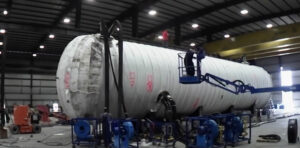The equipment setup on gas fire jobs is usually referred to in the industry as a “Gas Train.” Our goal is to educate you on some of the inner workings of all that equipment; what it is, what it does, and why it does it.
The Gas Train utilizes a mixture of dry gas and air to create combustion. It is made up of the Blower, Control Console, and High-Velocity Gas Burners. A gas vaporizer is also necessary when using fuel that is in a liquid state. We’ll go through them one by one, so you have an idea of what is going on during this highly specialized form of heat treatment.
- BLOWER
The blower provides the air in which to bum the fuel (LPG, natural gas, etc.) It thrusts air at about 1 psi where the pressure from the hot gases leave the burner at a distance of up to 60 ft.
- CONTROL CONSOLE
This console contains the gas regulator and ignition transformer. It controls the fuel flow to the burner, checks for correct fuel pressure, and checks and monitors the flame in the burner. In the event of a flame loss, an alarm is sounded and fuel supply is shut down.
2a. GAS REGULATOR
The regulator reduces the incoming gas pressure to 1-2 psi, suitable for use with the control train. It is adjustable and can be set lower for a low temperature start-up.
2b. IGNITION TRANSFORMER
The ignition transformer provides high Voltage, 8-10,000 volts, to the spark probe/electrode to light the burner. The transformer is for intermittent, not continuous use.

3. HIGH-VELOCITY GAS BURNERS
There are three high velocity gas burners we use regularly; 3,000,000 BTU/hr; and 6,000,000 BTU/hr to 10,000,000 BTU/hr. The 6-10 Mil burner is used most often on our larger firings or when a large volume of air flow is required. They are all nozzle mix burners.
6,000,000-10,000,000 BTU/hr Burner is a Stainless Steel burner. The ignition is by a spark plug within the burner body. The air inlet connection is 8″, in line with the flow and the volume control is at the blower. The gas connection is our standard 2″ gas hose.
The vaporizer is necessary when the gas being used is in a liquid state. LPG is used most often when a vaporizer is necessary and is transported and stored as a liquid under pressure. In order for your equipment to be able to use the propane1 in your storage vessel (cylinder or tank) it must undergo a phase change (vaporization) from liquid to vapor within the cylinder, before being combusted by the equipment. Many clients have a natural gas line at their facility and a vaporizer is not needed since the fuel is already in a gaseous state.




